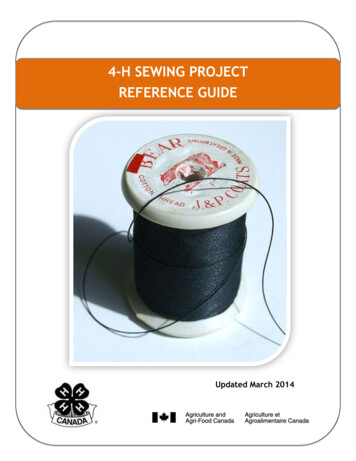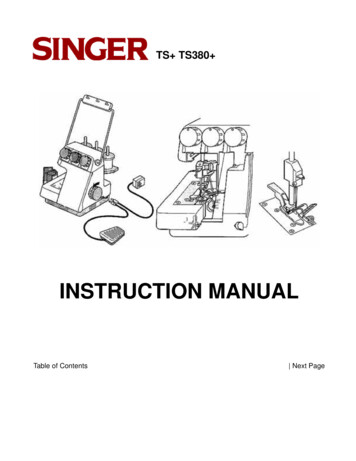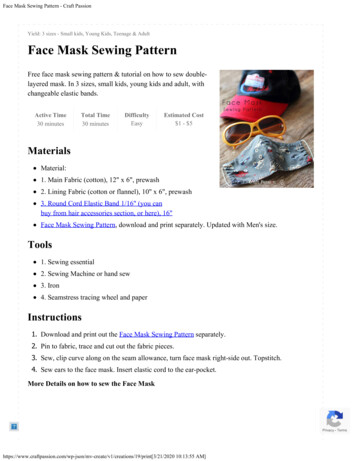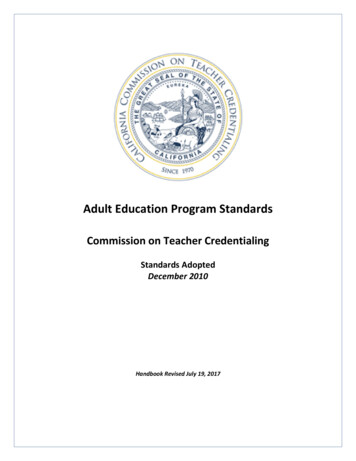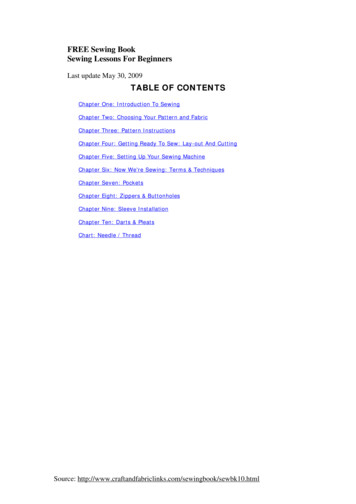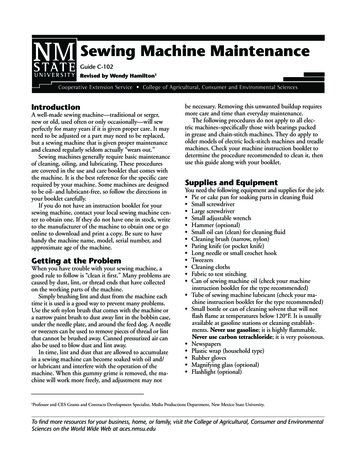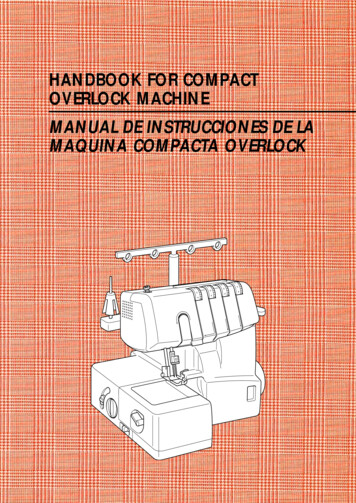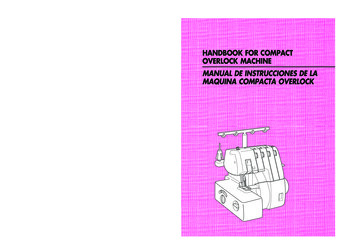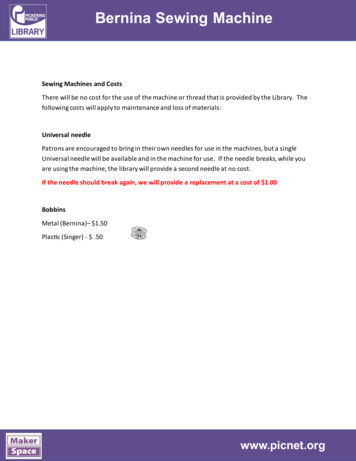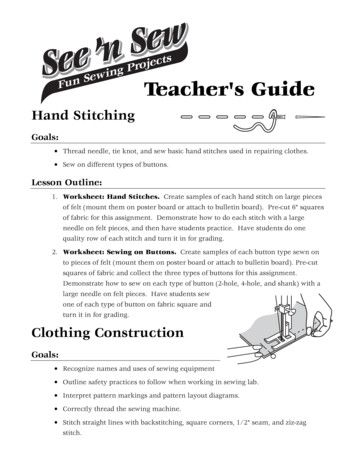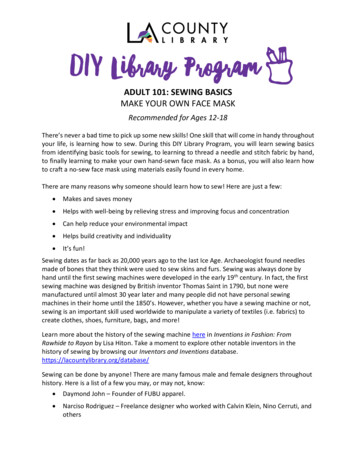
Transcription
-ADULT 101: SEWING BASICSMAKE YOUR OWN FACE MASKRecommended for Ages 12-18There’s never a bad time to pick up some new skills! One skill that will come in handy throughoutyour life, is learning how to sew. During this DIY Library Program, you will learn sewing basicsfrom identifying basic tools for sewing, to learning to thread a needle and stitch fabric by hand,to finally learning to make your own hand-sewn face mask. As a bonus, you will also learn howto craft a no-sew face mask using materials easily found in every home.There are many reasons why someone should learn how to sew! Here are just a few: Makes and saves money Helps with well-being by relieving stress and improving focus and concentration Can help reduce your environmental impact Helps build creativity and individuality It’s fun!Sewing dates as far back as 20,000 years ago to the last Ice Age. Archaeologist found needlesmade of bones that they think were used to sew skins and furs. Sewing was always done byhand until the first sewing machines were developed in the early 19th century. In fact, the firstsewing machine was designed by British inventor Thomas Saint in 1790, but none weremanufactured until almost 30 year later and many people did not have personal sewingmachines in their home until the 1850’s. However, whether you have a sewing machine or not,sewing is an important skill used worldwide to manipulate a variety of textiles (i.e. fabrics) tocreate clothes, shoes, furniture, bags, and more!Learn more about the history of the sewing machine here in Inventions in Fashion: FromRawhide to Rayon by Lisa Hiton. Take a moment to explore other notable inventors in thehistory of sewing by browsing our Inventors and Inventions ng can be done by anyone! There are many famous male and female designers throughouthistory. Here is a list of a few you may, or may not, know: Daymond John – Founder of FUBU apparel. Narciso Rodriguez – Freelance designer who worked with Calvin Klein, Nino Cerruti, andothers
Coco Chanel – Revolutionary female designer Ann Lowe – Famous African American female designer Clare Waight Keller – First female design chief of the House of Givenchy Jason Wu – Freelance designer; Michelle Obama wore his gown to the inaugural ballCan you name any other famous designers? Check out Biography in Context on our Databasespage to learn about other influential designers.Questions for Discussion: Why should someone learn how to sew? Who should learn to sew?Hands-on ActivitiesSo, let’s start learning how to sew! We will do 3 different activities showing the basics of handsewing.Activity #1 will help us identify the basic tools used for sewing.Activity #2 will teach you to thread a needle.Activity #3 will teach the basics of hand sewing by making a fabric face mask.Activity #1: Identify Tools of the TradeMatch the name of each object with its picture. Images found on the next page.1. Thread2. Needle3. Scissors4. Pins and pin cushion5. Ruler or Tape measure6. Fabric7. Pattern8. Thimble9. Fabric chalk or marker
BACDE EF EG EHI
Here are some helpful tips when using these tools: Thread color should match or be a shade darker than the color of the fabric. Do not use the sewing scissors for cutting other things like paper. Tailor’s chalk can be removed by wiping it off or with a damp cloth. Tape measures work better than rulers for patterns that are over 60 in long. Never put pins or needles in your mouth; use the pin cushion. Always wear shoes to stay safe from stepping on stray pins or needles. If you can, iron your fabric to help with cutting and sewing in a straight line.1. (G) 2. (F) 3. (D) 4. (H) 5. (A) 6. (B) 7. (E) 8. (C) 9. (I)ACTIVITY #1 ANSWER KEY:Activity #2: Threading a NeedleThreading a needle can be difficult since the thread and the eye (round end with the hole) of aneedle can be small. There is a tool called Needle Threader that can help. It is a small metal toolthat has a wire at the end. That wire lets you pinch the thread and slide it through the eye ofthe needle.This activity will show how to thread a needle without the threader.1. Cut the thread at an angle.2. Hold the thread between your thumb and index finger.3. Pinch down the thread until you can only see the tip between your fingers.4. Hold the needle (eye up) in your other hand.5. Bring the needle down onto the thread. Instead of pushing the thread up into the eye, bringthe eye of the needle down.6. Once the tip of the thread is into the eye, pull the thread through.7. Tie a knot once the thread is even.Watch this needle threading tutorial to see how this is done! https://youtu.be/ 9Fv8 P9FjI
Activity #3: Hand Sewn Face MaskIn this activity we will be showing you how to make a hand sewn face mask. You will need thematerials listed below: Scissors Fabric (cotton or cotton blend) Ruler Paper (11 x 14) and pen/pencil to make a pattern Needle Thread Pins and pin cushion Fabric chalk (optional)1. Make the Pattern – Using a ruler and pen/pencil, measure out on the sheet of paper thedimensions of your mask. Then cut it out, rounding the end from the ears.Length 19cmHeight 14 cmFront edge 1cmEar hole 2 cmEar edge 1.5 cm from top, back, and bottom2. Prepare the Mask PiecesA. Fold your fabric in half.B. Lay your pattern on top and trace it out onto the fabric.C. Cut it out (you should have 4 pieces).D. On two of the pieces, cut off the ear loops. These pieces will serve as extra lining.
3. Sew the Pieces TogetherBefore you start sewing, watch this tutorial about basichand stitches. https://youtu.be/1FknfumFPX8A. Pin the smaller pieces to the larger ones.Hint: Make sure that the sharp ends of the pins are pointingtoward the center of your material, so you do not pokeyourself.B. Sew those pieces together. Do not sew the side closes tothe ear hole. That will serve as a pocket for a filter.C. Once that is done, place the pieces on top of each other,making sure that the pockets are on the top and bottom ofthe mask.D. Pin together the edge. Sew the pieces together along thatedge. The side that is sewn will be the inside part of themask.E. Open it up and try it on!
Questions to Consider: Why do you think knowing how to sew is a good skill? What was the hardest part of the activity for you? How would you make the pattern smaller/larger? If you do not have pins, what else could you use to hold your work together?BONUS: Non-Sewn MaskIf you tried, but still do not like sewing, never fear! Here are two quick tutorials on no-sew facemasks provided by KRCR sew-instructionsFor this first mask you will need a piece of fabric (bandana, scarf, etc.), scissor, “filter” (coffeefilter, paper towel, tissue) and two rubber bands or elastic hair ties.
For this second mask you will need an old t-shirt, scissors, pen/marker and a ruler.3 things to remember about sewing:1. Learning to sew has a lot of mental, physical, and financial benefits.2. Anyone can learn how to sew. It doesn’t matter your age, gender or culture.3. Before you begin a project, make sure you have your tools and patterns.DIGITAL RESOURCES AVAILABLE THROUGH LA COUNTY LIBRARYeBooks & AudiobooksLA County Library offers numerous resources that can help you learn more about sewing andfashion. Here are just a few titles, all of which are available as eBooks on OverDrive, Libby andHoopla:Chaotic Good by Whitney GardnerSeventeen year-old Cameron loves two things: cosplay and her dreamschool, CalArts. When trolls go after her cosplay blog she decides toget even by dressing as a guy and pretending to be her brotherwhenever she goes into the local comic shop. After infiltrating themale-centered shop she plans to eventually reveal her true self, butwhen she unexpectedly falls for one of the guys in the local dungeonsand dragons crew, she forgets all about her revenge and about herapplication to CalArts.
The Fashion Committee by Susan JubyCharlie Dean is a style-obsessed girl who eats, sleeps, and breathesfashion. John Thomas-Smith is a boy who forges metal sculptures in hisgarage and couldn't care less about clothes. The two go head-to-headcompeting for a spot at an exclusive arts school where all their artisticdreams could come true.Valiant by Sarah McGuireSaville hates sewing. How can she not when her father, the Tailor, loveshis bolts of velvet and silk far more than he's ever loved her? Yet, whenhe is struck ill shortly after they arrive in the city of Reggen, Saville mustdon boy's clothes in the hopes of gaining a commission from the king tokeep them fed.Sewing Happiness: A Year of Simple Projects for Living Wellby Sanae IshidaWhen Sanae Ishida was diagnosed with a chronic illness and then losther corporate job, she decided to focus on things in her life that bringher joy. What she found was sewing. Ishida decided to only sew herand her daughter’s clothes for one year and then wrote about theexperience in this memoir/how-to book.Refinery29: Style Stalking by Piera GelardiGet set to build your best-ever wardrobe featuring the hardest-workinglooks from around the globe with Refinery29—the world's leading styledestination—as their editors break down the essentials of the everydaychic, straight from the street.
The Sewing Answer Book by Barbara Weiland TalbertThis informative and encouraging guide offers proven solutions to all ofyour most stubborn sewing problems. No matter your sewingexperience or whether you prefer to use a machine or sew by hand,The Sewing Answer Book will help you hone your skills while inspiringyou to try new and exciting techniques.
Coco Chanel – Revolutionary female designer Ann Lowe – Famous African American female designer Clare Waight Keller – First female design chief of the House of Givenchy Jason Wu – Freelance designer; Michelle Obama wore his gown to th
